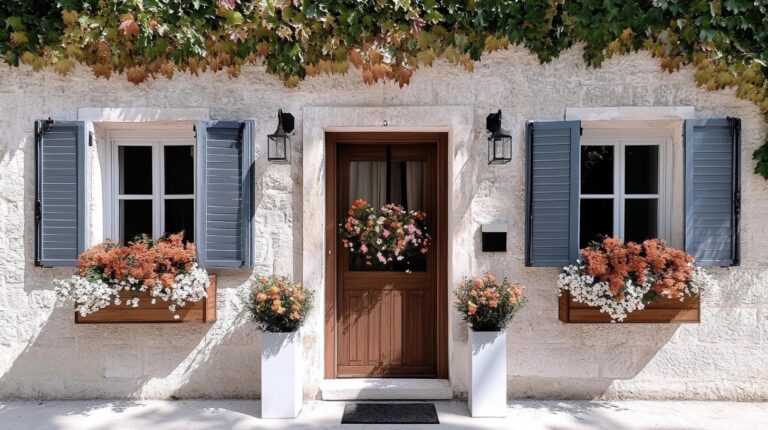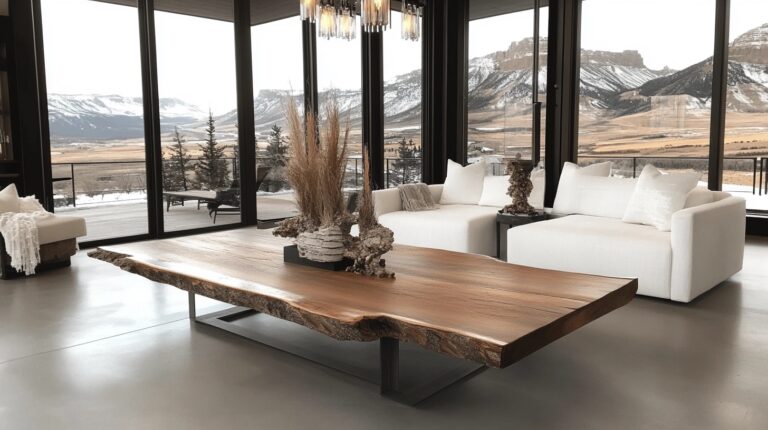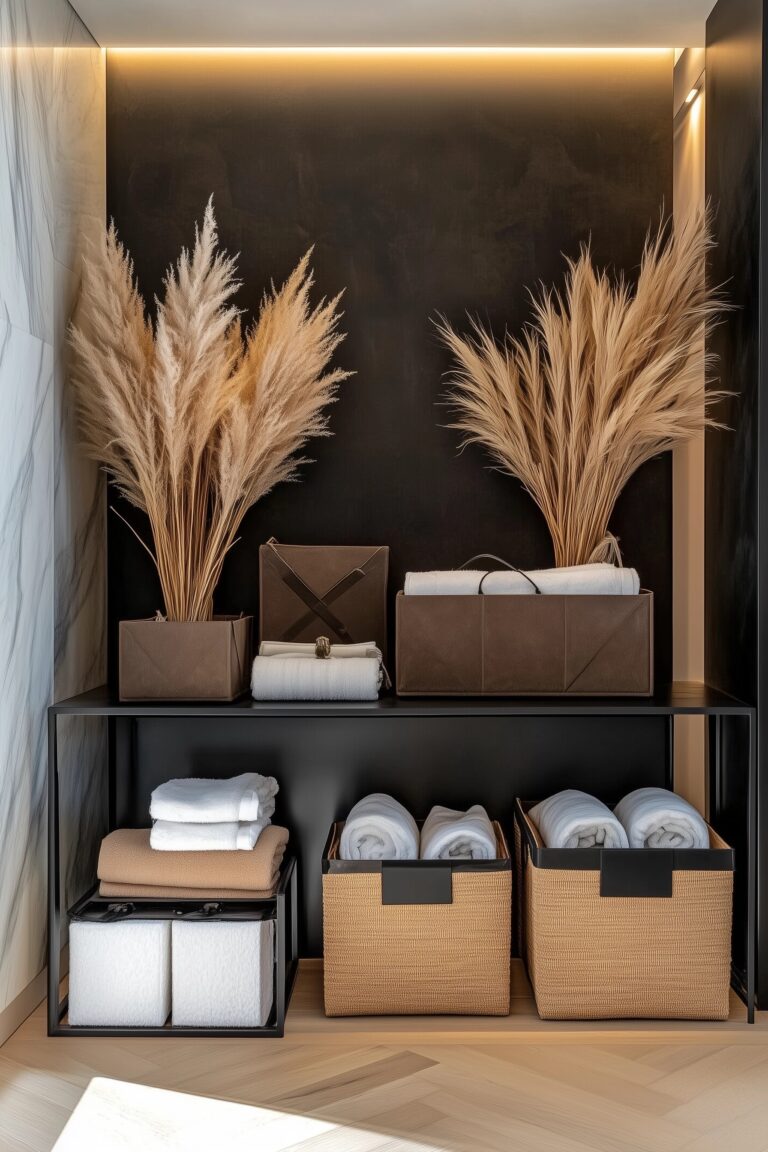Feeling a bit squeezed in your bedroom? Yeah, me too sometimes! But what if I told you that tiny space could become your favourite calm-down corner? Enter Japandi style – that gorgeous blend of Japanese simplicity and Scandi comfort. It’s like magic for making small bedrooms feel serene, airy, and way more spacious than they are. Let’s explore how to bring this peaceful vibe into your own compact retreat!
16 Effortless Japandi Small Bedroom Ideas for a Serene & Cozy Retreat
1. Embrace a Calming Neutral Palette
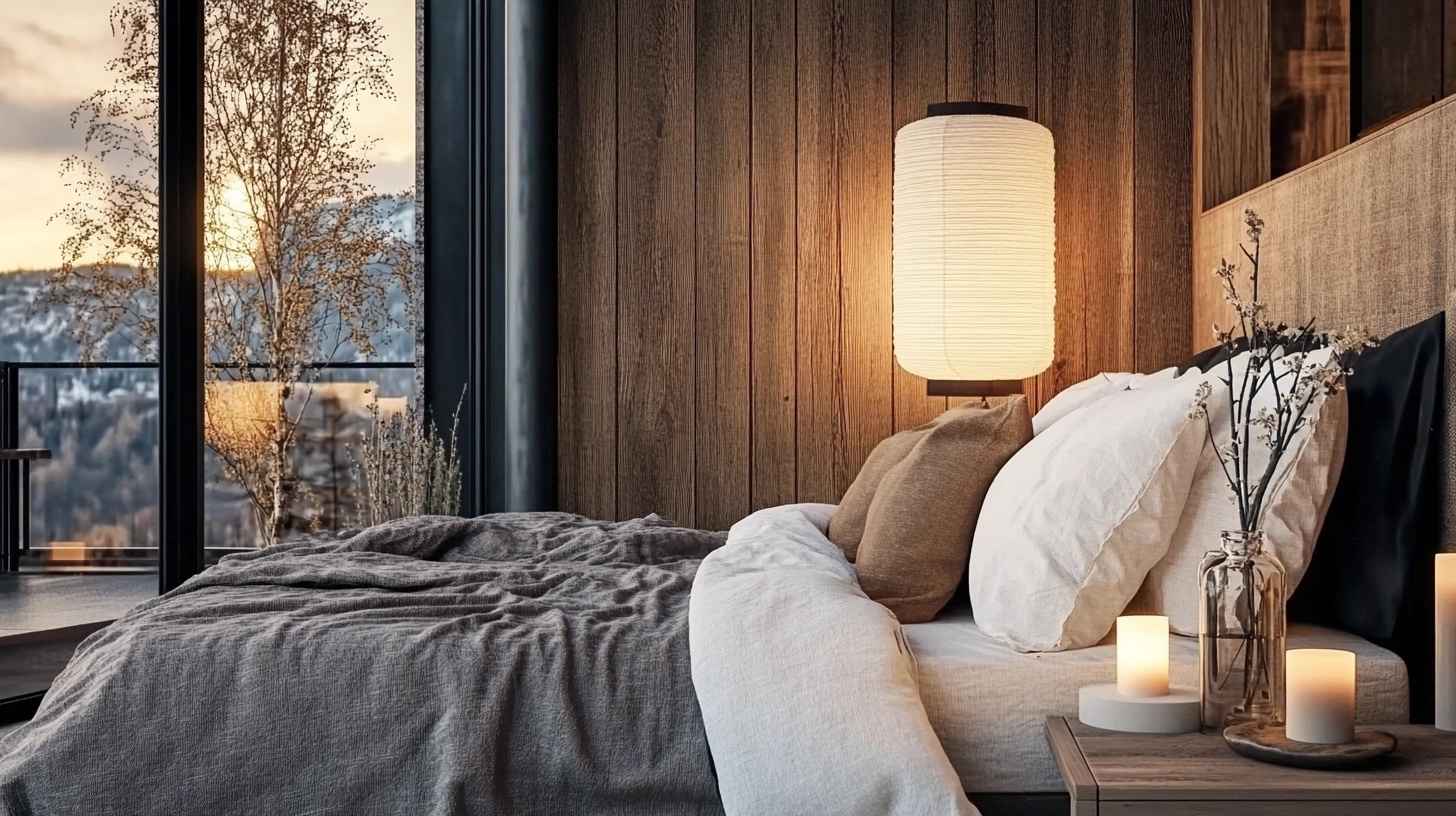
This room uses shades of grey, white, and warm wood to create a deeply calming atmosphere, perfect for unwinding. The subtle contrast prevents it from feeling bland while staying true to Japandi principles.
The foundation of any Japandi space, especially a small one, is its color palette. Think soft, muted tones inspired by nature – shades of white, cream, beige, taupe, stone grey, and warm wood tones. These colors create a soothing backdrop that reflects light, making the room feel instantly larger and more peaceful. I find sticking to just a few core neutrals prevents visual clutter. You can always add subtle hints of color later with textiles or minimal decor, perhaps a muted green or dusty blue, but starting neutral is key for that signature Japandi calm.
2. Maximize Natural Light for an Airy Feel
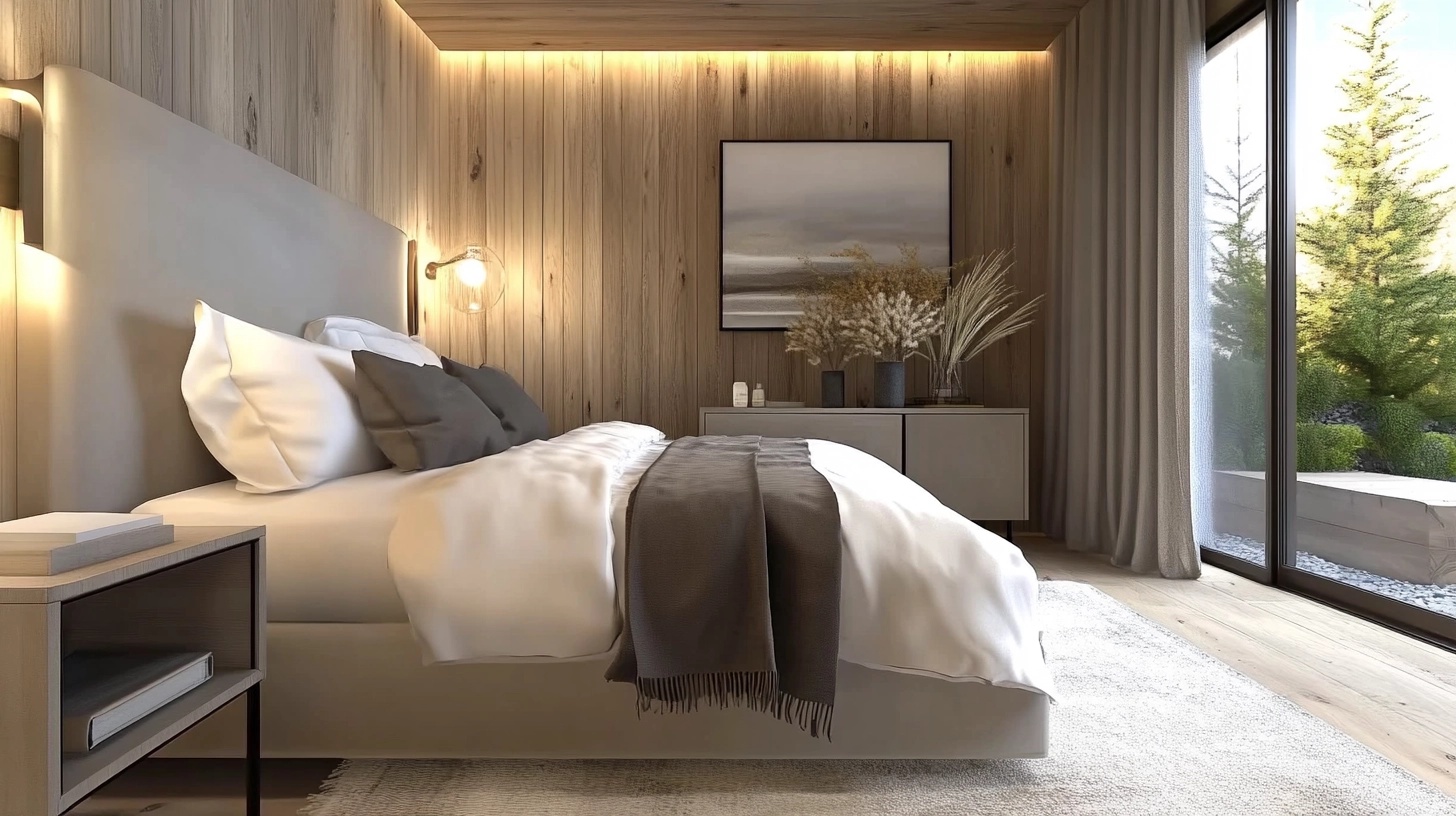
Large windows dressed in sheer curtains allow maximum daylight while maintaining privacy. The light wood tones further enhance the bright, airy quality essential for Japandi small bedroom design.
Oh, natural light – it’s like a magic wand for small spaces! Japandi design heavily emphasizes maximizing daylight. Keep window treatments minimal; think sheer linen curtains, simple blinds, or even bare windows if privacy allows. Avoid heavy, dark drapery that blocks light and visually shrinks the room. Position furniture, especially mirrors, to help bounce light around. If your room lacks large windows, strategically placed artificial lighting (which we’ll cover later!) can help mimic that bright, open feeling. Trust me, letting the light pour in makes a world of difference.
3. Choose a Low-Profile Bed Frame for Grounding Energy
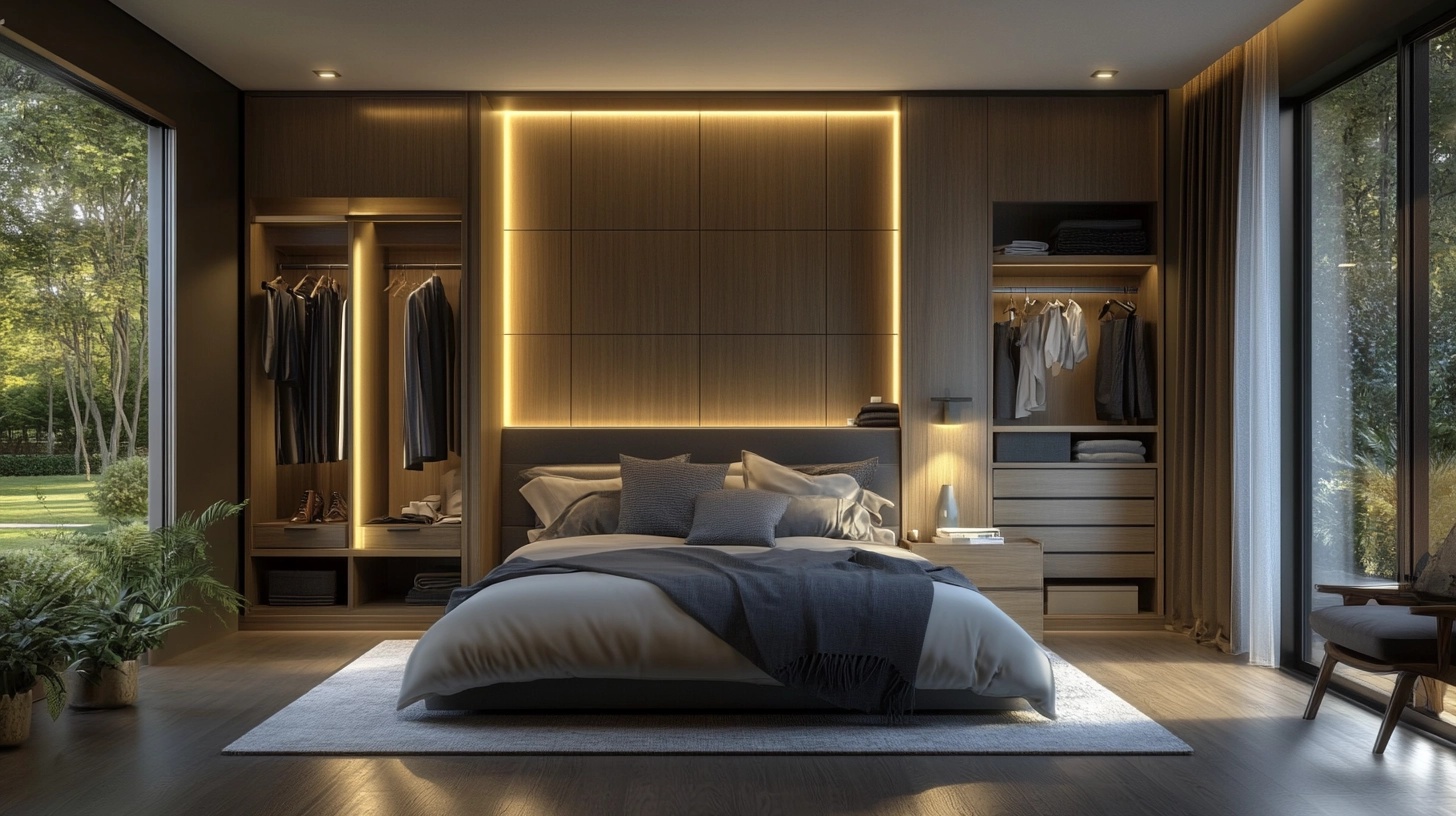
A low bed frame, common in Japanese design, visually opens up the vertical space, making ceilings feel higher. It also fosters a connection to the ground, promoting calm.
One of the most impactful choices you can make in a Japandi small bedroom is opting for a low-profile bed frame. Inspired by traditional Japanese futons, these beds sit closer to the ground, creating an illusion of higher ceilings and more open space above. It’s amazing how much visual volume this frees up! Look for simple designs in natural wood or with minimal upholstery. This choice not only maximizes perceived space but also contributes to that grounded, calming energy that Japandi style is known for. It instantly makes the room feel more serene and less cramped.
4. Incorporate Warm, Natural Wood Elements

This stunning bedroom uses warm wood paneling extensively, creating a cocooning yet sophisticated effect. The integration with lighting and storage maintains a sleek, uncluttered look.
Wood is the heart and soul of Japandi design, bridging the gap between Scandi warmth and Japanese naturalism. Incorporating warm, natural wood elements is essential for adding texture, depth, and a connection to nature. Think beyond just the bed frame – consider wood side tables, accent paneling (like in this gorgeous example!), shelving, or even simple wooden decor pieces. Opt for light-to-medium tones like oak, ash, maple, or bamboo. The key is to let the natural grain and texture shine through, adding organic beauty without overwhelming the small space.
5. Layer Soft, Organic Textures

Even in a minimalist setting, layering textures like soft linens, smooth cotton, and potentially a knit throw adds warmth and comfort. Notice how the neutral bedding still offers visual interest through texture.
While Japandi is minimalist, it’s far from cold! The secret lies in layering soft, organic textures to create a cozy and inviting feel – that Scandi *hygge* influence. Think natural materials like linen bedding (my personal favorite for its relaxed look!), cotton throws, wool rugs, or even woven baskets for storage. These textures add visual interest and tactile comfort without relying on busy patterns or bright colors. Stick to your neutral palette but play with different weaves and materials to add depth. It makes the space feel touchable, comfortable, and incredibly serene.
6. Opt for Minimalist, Functional Furniture Pieces

This bedroom showcases minimalist furniture with clean lines – a low bed, simple side table, and vertical mirror. Each piece serves a clear purpose without adding visual bulk.
In a small bedroom, every piece of furniture counts. Japandi design champions minimalism and functionality. Choose pieces with clean lines, simple forms, and a clear purpose. Avoid overly ornate or bulky furniture. Look for multi-functional items where possible – perhaps a bench at the end of the bed that offers seating and storage, or a narrow console table that can double as a small desk or vanity. Prioritize quality craftsmanship and natural materials. The goal is furniture that feels light, supports the room’s function, and doesn’t visually clutter the limited space.
7. Declutter for Ultimate Japandi Bedroom Small Space Serenity
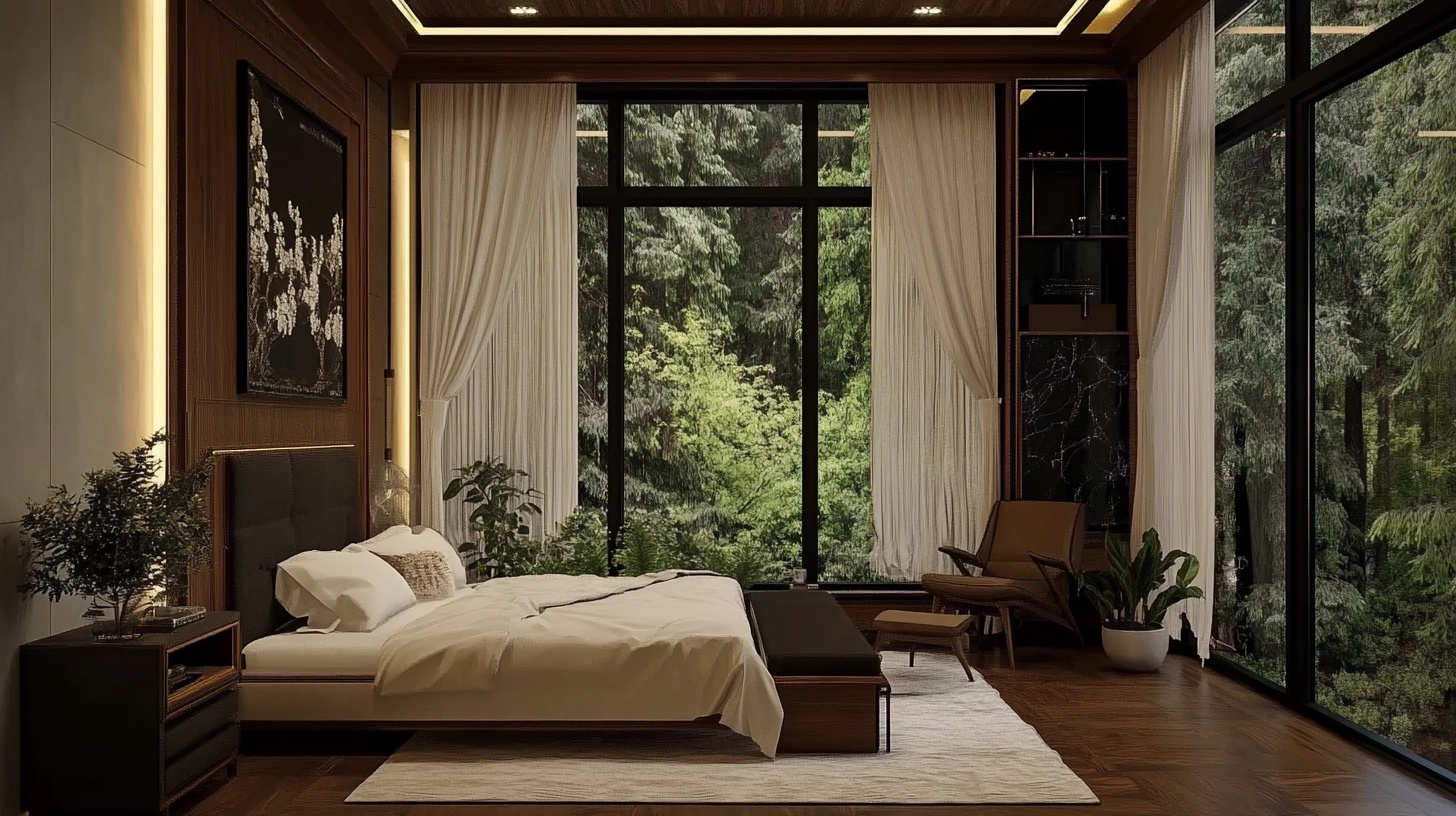
A truly serene Japandi bedroom relies on intentional decluttering. Keeping surfaces clear and only displaying meaningful items creates visual calm and enhances the feeling of space.
Okay, let’s talk about the ‘elephant’ in many small rooms: clutter! Achieving that peaceful Japandi vibe absolutely requires a commitment to decluttering. It’s fundamental to both Japanese minimalism and Scandi practicality. Take a good look around your bedroom – what do you truly need and love? Find storage solutions (more on that next!) for essentials and be ruthless about removing anything unnecessary. Clear surfaces are key! A tidy space not only looks bigger but feels infinitely more calming. It might take effort, but embracing ‘less is more’ is transformative for a small bedroom.
8. Implement Smart Hidden Storage Solutions
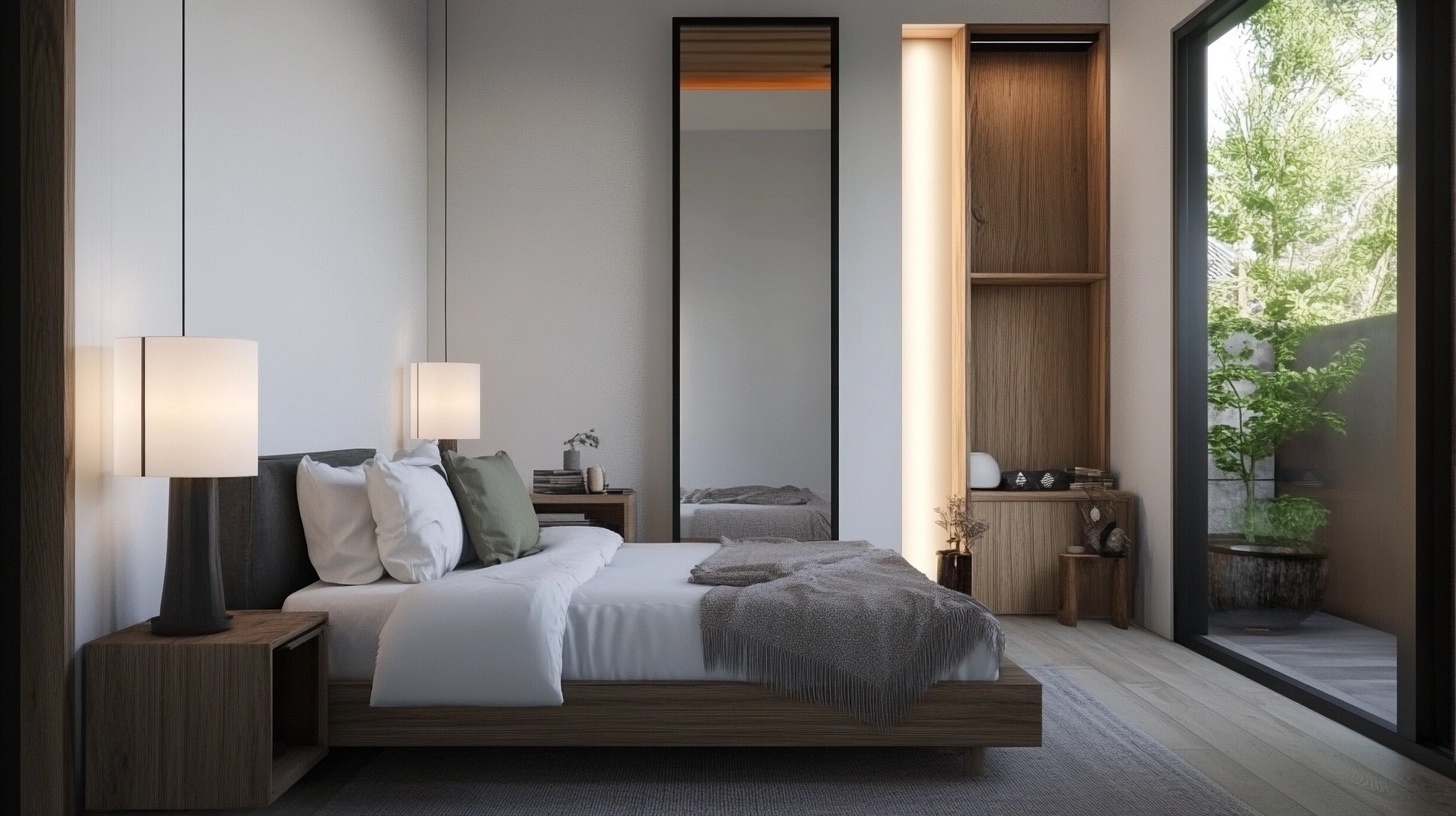
Built-in wardrobes or cabinets that blend seamlessly with the walls are ideal for Japandi small bedrooms. This keeps belongings organized and out of sight, maintaining the minimalist aesthetic.
So, where does everything go after decluttering? Smart storage! In a Japandi small bedroom, hidden storage is your best friend. Think built-in wardrobes painted the same color as the walls, under-bed storage drawers, platform beds with integrated storage, or minimalist cabinets with clean fronts. Woven baskets on shelves can also corral smaller items stylishly. The goal is to keep belongings organized and out of sight, preserving that clean, uncluttered look. Avoid open shelving overflowing with items; concealed storage maintains the visual serenity that’s crucial in a compact space.
9. Bring Nature Indoors with Simple Greenery

Incorporating simple potted plants adds life and improves air quality. Choose plants with interesting leaf shapes but avoid overly fussy arrangements to maintain the Japandi aesthetic.
Bringing a touch of the outdoors in is a cornerstone of both Japanese and Scandinavian design. Adding simple greenery to your Japandi small bedroom instantly injects life, color (in a natural way!), and purifies the air. You don’t need an indoor jungle – often, less is more. A single, well-chosen plant like a bonsai, snake plant, or a delicate fern in a simple ceramic or terracotta pot can make a significant impact. Place it on a windowsill, a bedside table, or a minimalist plant stand. It’s amazing how a little bit of green can enhance the room’s connection to nature and boost its serene vibe.
10. Select Mindful Decor & Wabi-Sabi Accents
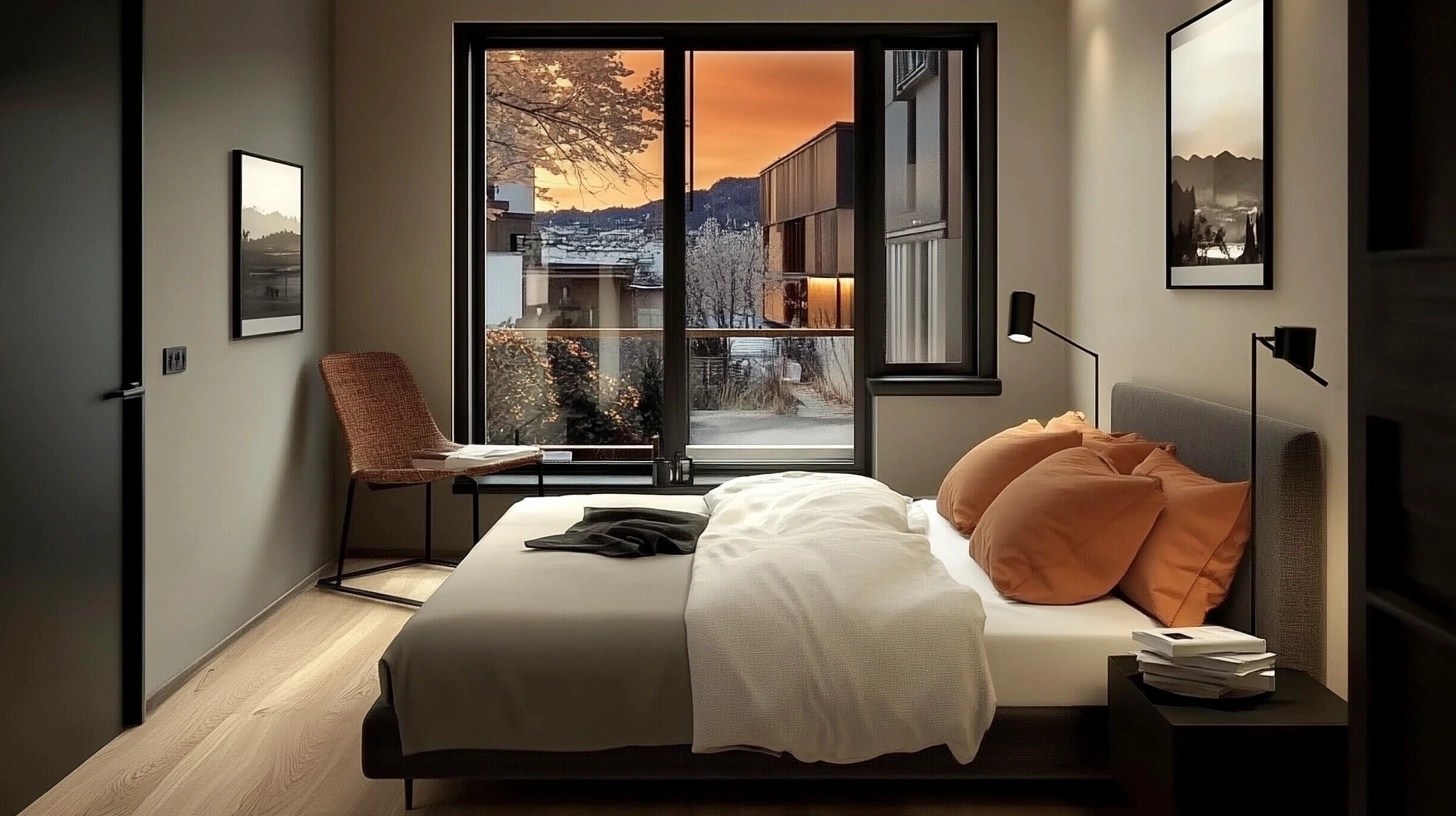
This space uses minimal, carefully chosen decor, like the woven chair and simple art. Embrace wabi-sabi by appreciating items with natural imperfections or handcrafted character.
Japandi isn’t about sterile emptiness; it’s about mindful curation. When choosing decor for your small bedroom, select items that are meaningful, functional, or bring you joy. Embrace the Japanese concept of wabi-sabi – finding beauty in imperfection, impermanence, and authenticity. This could mean a handcrafted ceramic vase, a naturally weathered piece of wood, a single piece of abstract art with organic lines, or textiles with subtle imperfections. Avoid cluttering surfaces; instead, let each carefully chosen piece have room to breathe. This thoughtful approach to decor adds personality and soul without sacrificing serenity.
11. Genius Layouts for a Japandi Small Apartment Bedroom
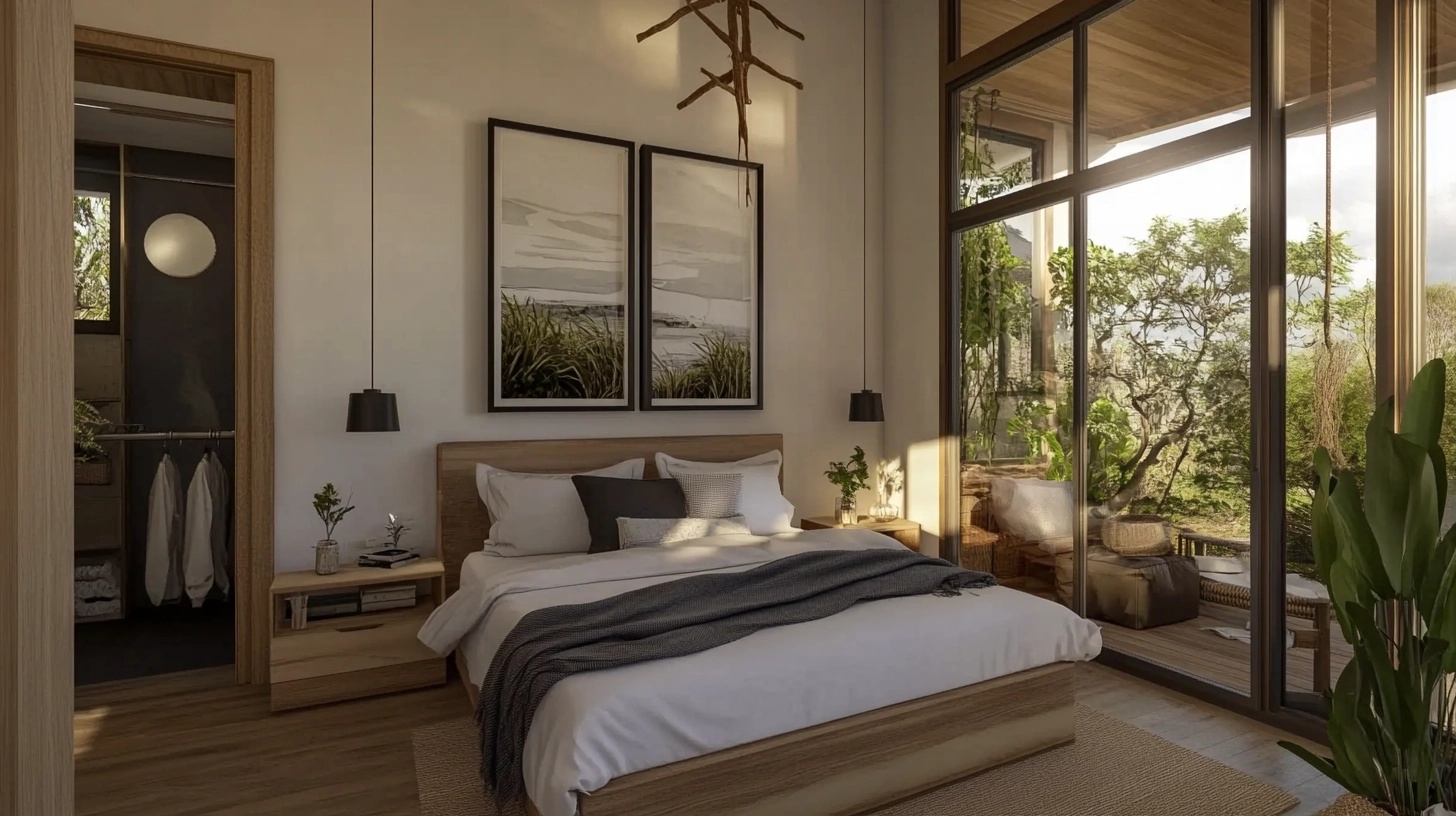
This apartment bedroom utilizes a thoughtful layout, placing the bed strategically and using appropriately scaled furniture. Pendant lights free up bedside table space, a great trick for small rooms.
Living in a small apartment often means dealing with a truly tiny bedroom. This is where Japandi principles really shine! Think vertically – use wall-mounted shelves or lighting to free up floor space. Consider a platform bed with drawers underneath. Position the bed to maximize flow and access to windows or closets. In a studio or one-bedroom condo, you might use a minimalist screen or open shelving unit to subtly delineate the sleeping area. It’s all about creative problem-solving and choosing furniture that works hard without taking up too much visual or physical space. Look how this room uses pendant lights instead of bulky lamps – so clever!
12. Create a Welcoming Japandi Guest Bedroom Retreat
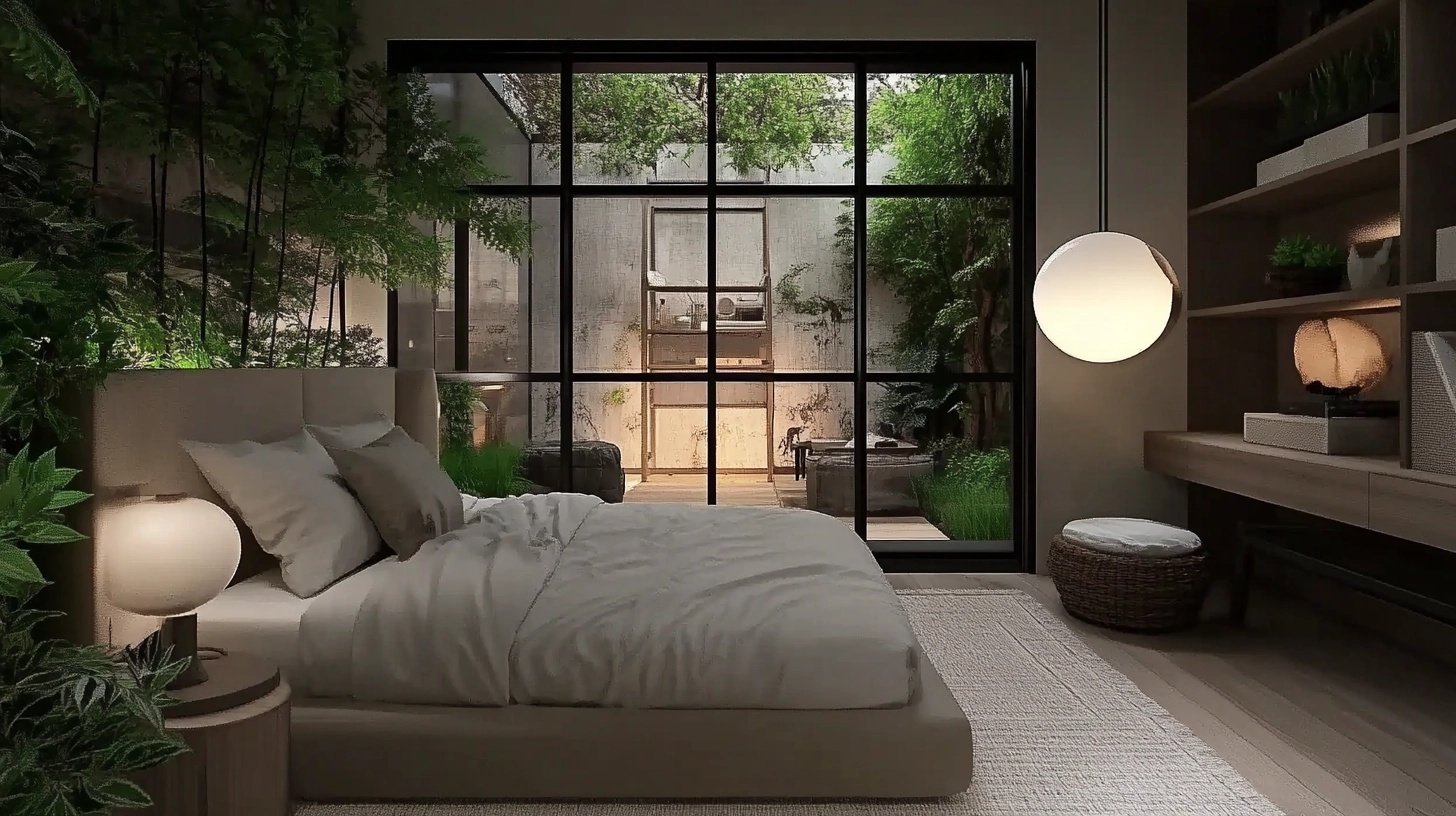
Applying Japandi style to a guest room creates a universally appealing and calming space. Focus on comfort essentials: good bedding, clear surfaces, simple lighting, and a clutter-free feel.
Have a small spare room you use for guests? Applying Japandi principles can turn it into a wonderfully serene and welcoming retreat! Since it’s not your primary bedroom, you can keep things even more minimal. Focus on the essentials: a comfortable bed with soft, neutral linens, simple bedside tables, adequate lighting (like this lovely pendant!), and accessible storage (maybe a luggage rack or clear space in a closet). Keep personal clutter to a minimum so your guests feel like the space is truly for them. A calm, clean, Japandi guest bedroom feels thoughtful and relaxing – way better than a room that doubles as a dumping ground!
13. A Soothing Take on the Japandi Kids Bedroom

While this image shows a sophisticated adult room, the core elements – wood tones, built-in storage, ample light – create a great base for a Japandi kids’ room. Add subtle playful touches and easy-access toy storage.
Can Japandi work for kids? Absolutely! While you’ll naturally need more storage for toys and perhaps a touch more color, the core principles create a wonderfully soothing environment for children. Stick with a neutral base (light woods, whites, greys) and add pops of muted color through bedding, rugs, or artwork. Prioritize functional, closed storage to easily hide away toy clutter. Choose durable, natural materials. A calm bedroom environment can actually be beneficial for kids’ sleep and focus. Think simple shapes, soft textures, and plenty of floor space for play, all while maintaining that serene Japandi feel.
14. Cozy Up Your Japandi Attic or Loft Bedroom
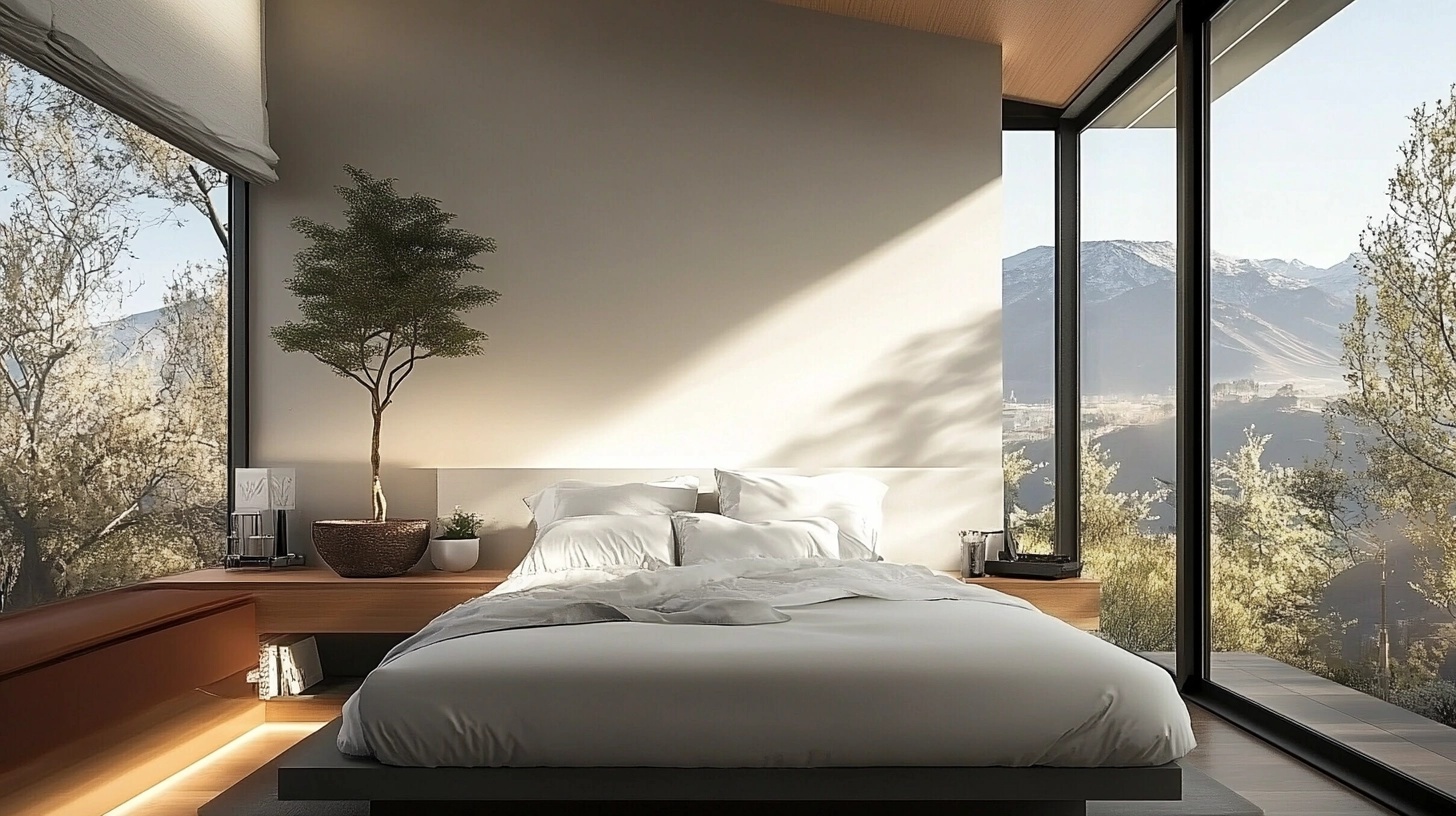
Attic or loft spaces often have unique architectural features. Embrace them! Low furniture works well with sloped ceilings, and large windows or skylights are a huge bonus for that Japandi light-filled feel.
Attic or loft bedrooms often come with unique challenges – sloped ceilings, awkward corners, maybe limited height. But these spaces can also be incredibly cozy and characterful, making them perfect candidates for Japandi style! Lean into the architecture. Low-profile beds are ideal under slopes. Use light colors to counteract any darkness and maximize light from skylights or windows. Keep furniture minimal and low to the ground. Embrace the cozy angles by adding soft textiles like plush rugs and layered bedding. A Japandi attic bedroom can feel like a secret, serene treetop escape.
15. Use Mirrors to Enhance Light and Perception of Space
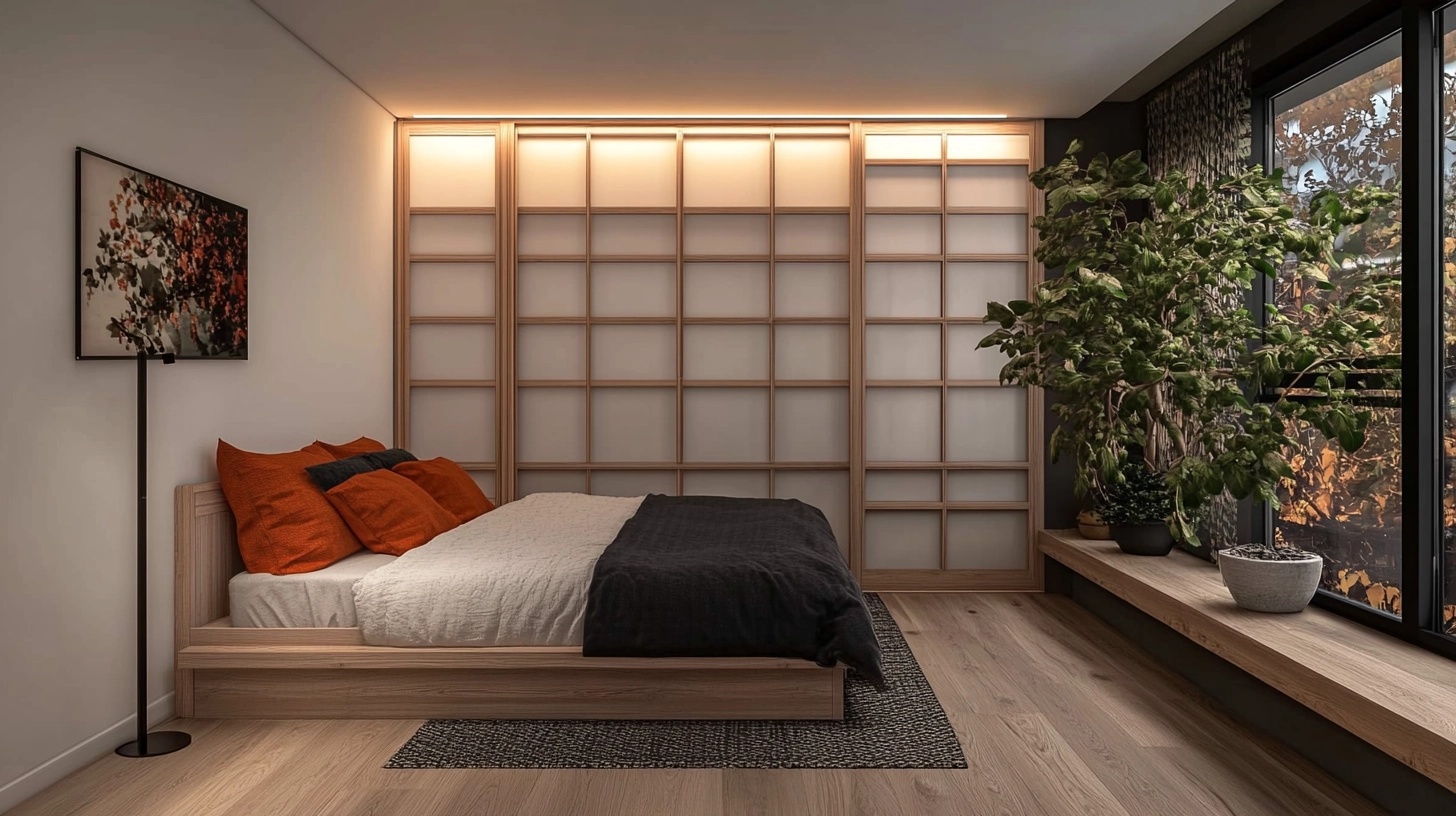
While not a traditional mirror, the light-colored, smooth surface of these shoji-style doors reflects light, similar to how a mirror would, helping to brighten the room and make it feel larger. A large mirror placed opposite a window would achieve a similar effect.
Mirrors are a classic trick for making small spaces feel larger, and they work beautifully in Japandi design. A well-placed mirror can double the perception of space and bounce natural light around the room, making it feel brighter and airier. Choose mirrors with simple, clean frames – think thin black metal, natural wood, or even frameless designs. Placing a large mirror opposite a window is particularly effective for maximizing light. You can also use mirrored closet doors or even reflective surfaces like the shoji screens shown here to subtly enhance the feeling of spaciousness without sacrificing the minimalist aesthetic.
16. Layer Soft, Ambient Lighting for Evening Calm
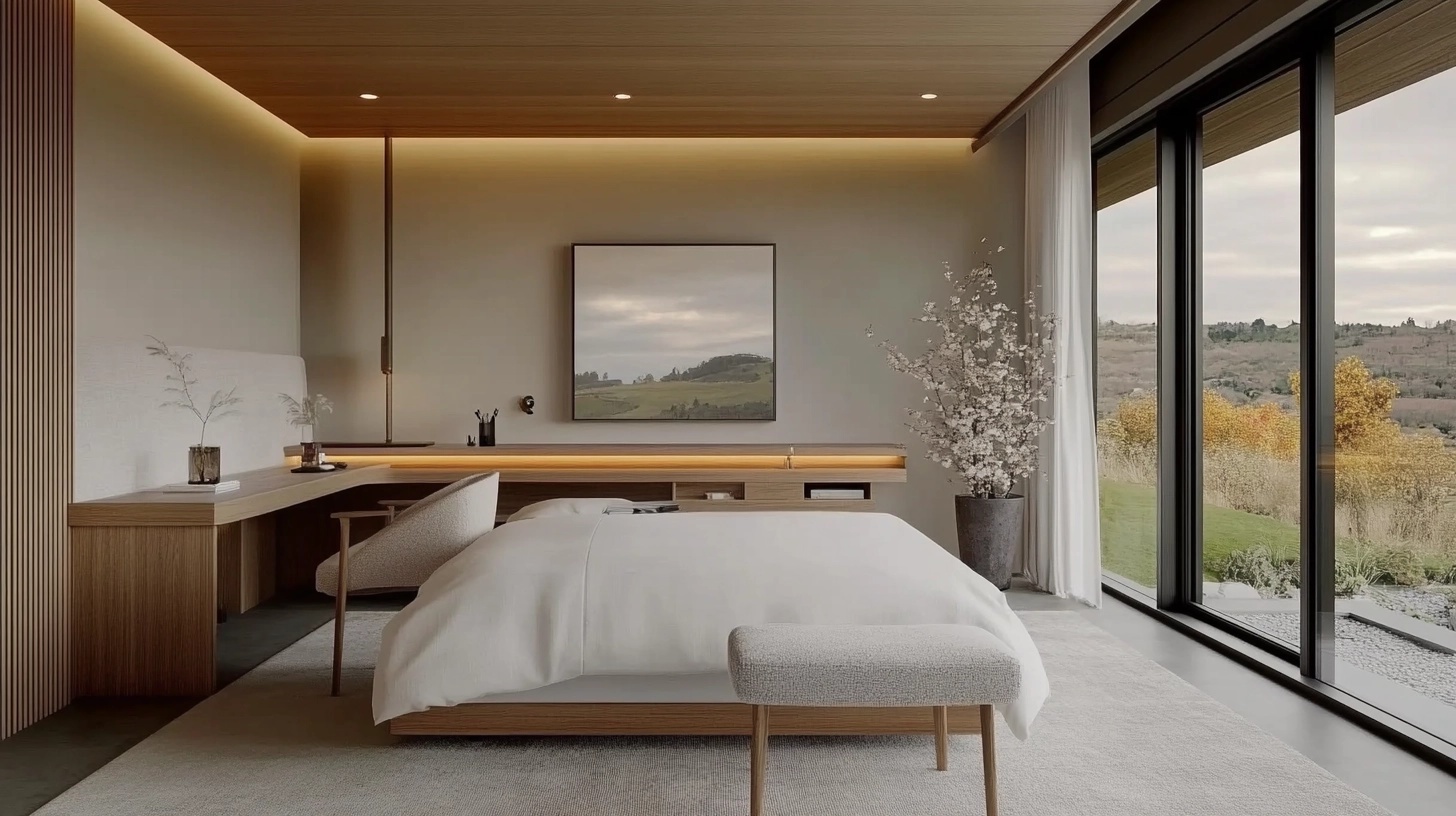
Good lighting is crucial. This room uses multiple light sources – recessed ceiling lights, task lighting at the desk – to create a layered, warm, and functional ambiance perfect for evenings.
While maximizing natural light is key for daytime, creating the right atmosphere in the evening requires thoughtful artificial lighting. Japandi style favors soft, warm, layered lighting rather than harsh overhead fixtures. Combine different sources: subtle recessed lighting, a beautiful pendant light (perhaps a paper lantern style?), wall sconces for ambient glow, and task lighting like a simple bedside lamp for reading. Use dimmers wherever possible to adjust the mood. The goal is to create a warm, inviting, and functional lighting scheme that enhances the room’s serenity as day turns to night. It makes such a difference to how relaxing the space feels!
Creating a Japandi small bedroom is all about finding that sweet spot between simplicity, functionality, and natural warmth. By incorporating these ideas, you can transform even the tiniest space into a serene sanctuary you’ll love retreating to!
Frequently Asked Questions
Q1: Why is Japandi style particularly good for a small bedroom?
A1: Japandi excels in small bedrooms because it emphasizes minimalism, functionality, and a clutter-free environment. Its use of neutral palettes, natural light, and simple forms creates an illusion of spaciousness and promotes a calm, serene atmosphere essential for restful sleep.
Q2: How can I incorporate Japandi design into a small guest bedroom?
A2: For a small guest bedroom, focus on essential comforts with Japandi principles: provide a comfortable bed with natural linens, simple side tables, adequate lighting, and perhaps a single piece of nature-inspired art. Keep decor minimal and ensure storage (like under-bed boxes) is available to keep the space tidy and welcoming.
Q3: Can Japandi style work in a small apartment bedroom or loft space?
A3: Absolutely! Japandi is ideal for small apartment bedrooms or lofts due to its space-saving focus. Utilize multi-functional furniture, maintain a light and airy color scheme, maximize natural light, and use clean lines to define zones without visual clutter, making the most of limited square footage.

